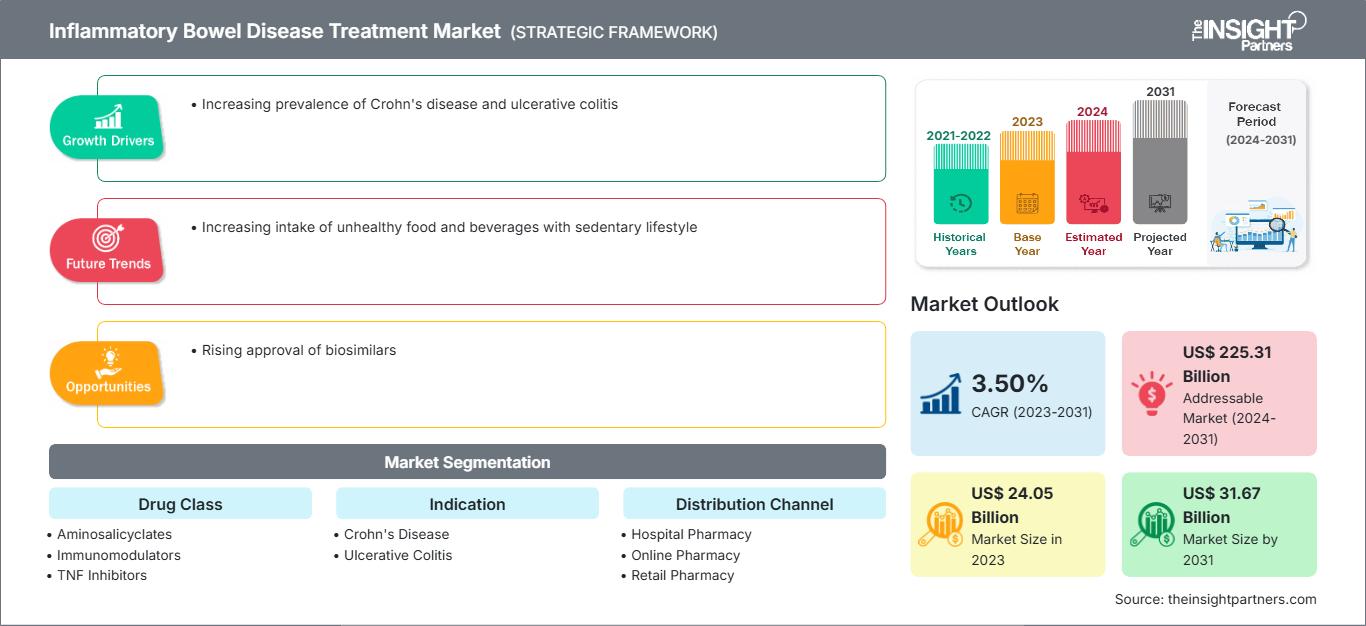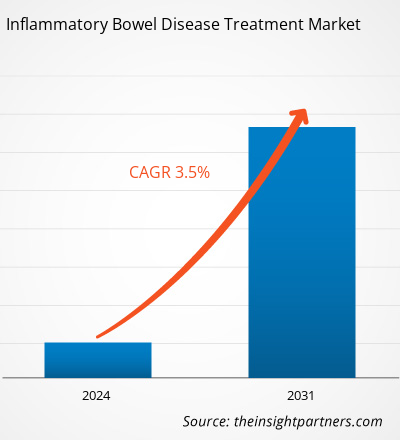La valeur du marché du traitement des maladies inflammatoires chroniques de l'intestin devrait passer de 24,05 milliards de dollars américains en 2023 à 31,67 milliards de dollars américains en 2031 ; le marché devrait enregistrer un TCAC de 3,50 % entre 2023 et 2031.
Analyses du marché et point de vue des analystes :
Les maladies inflammatoires chroniques de l'intestin (MICI) sont des affections inflammatoires chroniques du tractus gastro-intestinal, notamment la maladie de Crohn et la rectocolite hémorragique. Ces affections provoquent une inflammation de la muqueuse du tube digestif, entraînant des symptômes tels que des douleurs abdominales, de la diarrhée, de la fatigue et une perte de poids. Le traitement vise à réduire l'inflammation, à gérer les symptômes et à prévenir les complications grâce à des médicaments, des changements de mode de vie et parfois une intervention chirurgicale. La prise en charge des MICI nécessite généralement des soins médicaux et une surveillance continus pour maintenir la rémission et améliorer la qualité de vie. Les principaux facteurs de croissance du marché du traitement des maladies inflammatoires chroniques de l'intestin (MICI) sont la prévalence croissante de la maladie de Crohn et de la rectocolite hémorragique, ainsi que le nombre croissant de lancements de produits. Ce rapport présente les perspectives de croissance en fonction des tendances actuelles du marché du traitement des MICI et de leur impact prévisible au cours de la période de prévision. Les avancées technologiques devraient entraîner des tendances significatives sur ce marché dans les années à venir. De plus, le développement de traitements innovants grâce à la recherche continue et aux initiatives gouvernementales encourageantes devraient également stimuler la croissance du marché.
Moteurs de croissance et défis :
La maladie de Crohn est une maladie chronique complexe qui touche principalement le système digestif. La Bibliothèque nationale de médecine a indiqué qu'il y avait 825 cas de MICI pour 100 000 personnes en 2023, contre 410 cas de maladie de Crohn et 414 cas de rectocolite hémorragique et de MICI-u. Avec une prévalence de 0,82 %, 322 600 Canadiens étaient atteints d’une MII en 2023. Les patients atteints d’une maladie gastro-intestinale présentent un risque accru de détérioration nutritionnelle en raison des exigences de jeûne des tests diagnostiques, des restrictions alimentaires thérapeutiques et de la perte d’appétit due à l’anorexie ou à la modification des besoins nutritionnels causée par la maladie elle-même. Ainsi, la nutrition entérale est prescrite aux patients atteints de maladies gastro-intestinales, car la voie entérale est privilégiée pour fournir les nutriments nécessaires. Par conséquent, la prévalence croissante de la maladie de Crohn et de la colite ulcéreuse stimule la croissance du marché du traitement des maladies inflammatoires chroniques de l’intestin.
La maladie de Crohn, les maladies gastro-intestinales dues à un traumatisme, l’occlusion intestinale (OB), la colite microscopique, le syndrome de l’intestin court et la colite ulcéreuse sont quelques-unes des maladies gastro-intestinales courantes. Selon un article publié dans Healthline en 2021, environ 40 % des personnes dans le monde étaient touchées par des troubles gastro-intestinaux fonctionnels. La Fondation canadienne pour la santé digestive affirme que des millions de Canadiens vivent avec des maladies digestives ; Environ 20 millions de Canadiens, soit deux personnes sur trois, souffrent de troubles digestifs chaque année.
D'autre part, le coût élevé du traitement des maladies inflammatoires chroniques de l'intestin (MICI) constitue un obstacle important au marché du traitement des MICI. Des médicaments coûteux aux hospitalisations et interventions chirurgicales fréquentes, la prise en charge des MICI peut représenter un lourd fardeau financier pour les patients et les systèmes de santé. Le coût limite souvent l'accès à des soins optimaux et à des traitements innovants pour de nombreuses personnes atteintes de MICI. Il est crucial de s'attaquer aux problèmes d'accessibilité et de coût pour améliorer les résultats et la qualité de vie des patients atteints de cette maladie chronique. Ainsi, le coût élevé du traitement freine la croissance du marché du traitement des MICI.
Personnalisez ce rapport en fonction de vos besoins
Vous bénéficierez d’une personnalisation sur n’importe quel rapport - gratuitement - y compris des parties de ce rapport, ou une analyse au niveau du pays, un pack de données Excel, ainsi que de profiter d’offres exceptionnelles et de réductions pour les start-ups et les universités
Marché du traitement des maladies inflammatoires chroniques de l'intestin: Perspectives stratégiques

- Obtenez les principales tendances clés du marché de ce rapport.Cet échantillon GRATUIT comprendra une analyse de données, allant des tendances du marché aux estimations et prévisions.
Vous bénéficierez d’une personnalisation sur n’importe quel rapport - gratuitement - y compris des parties de ce rapport, ou une analyse au niveau du pays, un pack de données Excel, ainsi que de profiter d’offres exceptionnelles et de réductions pour les start-ups et les universités
Marché du traitement des maladies inflammatoires chroniques de l'intestin: Perspectives stratégiques

- Obtenez les principales tendances clés du marché de ce rapport.Cet échantillon GRATUIT comprendra une analyse de données, allant des tendances du marché aux estimations et prévisions.
Segmentation et portée du rapport :
L'analyse du marché du traitement des maladies inflammatoires chroniques de l'intestin a été réalisée en prenant en compte les segments suivants : classe de médicaments, indication de la maladie et canal de distribution. Sur la base de la géographie, le marché du traitement des maladies inflammatoires chroniques de l'intestin est segmenté en Amérique du Nord (États-Unis, Canada et Mexique), Europe (Royaume-Uni, Allemagne, France, Italie, Espagne et reste de l'Europe), Asie-Pacifique (Chine, Japon, Inde, Australie, Corée du Sud et reste de l'Asie-Pacifique), Moyen-Orient et Afrique (Émirats arabes unis, Arabie saoudite, Afrique du Sud et reste du Moyen-Orient et de l'Afrique), et Afrique du Sud et Amérique centrale (Brésil, Argentine et reste de l'Amérique du Sud et centrale).
Analyse segmentaire :
Informations basées sur les classes de médicaments
En fonction de la classe de médicaments, le marché est segmenté en produits biologiques, aminosalicyclates, corticostéroïdes et autres. Le segment des produits biologiques détenait la plus grande part de marché du traitement des maladies inflammatoires chroniques de l'intestin en 2023, et il devrait enregistrer le TCAC le plus élevé entre 2023 et 2031.
Informations basées sur les indications de la maladie
En fonction de l'indication de la maladie, le marché du traitement des maladies inflammatoires chroniques de l'intestin est divisé en maladie de Crohn et rectocolite hémorragique. Le segment de la maladie de Crohn devrait détenir une part de marché significative d'ici 2031.
Informations basées sur les indications des maladies
Selon les canaux de distribution, le marché est classé en pharmacie hospitalière, pharmacie de détail et pharmacie en ligne. Le segment de la pharmacie hospitalière devrait détenir une part de marché significative du traitement des maladies inflammatoires chroniques de l'intestin d'ici 2031.
Aperçu régional du marché du traitement des maladies inflammatoires chroniques de l'intestin
Les tendances régionales et les facteurs influençant le marché du traitement des maladies inflammatoires chroniques de l'intestin (MICI) tout au long de la période de prévision ont été analysés en détail par les analystes de The Insight Partners. Cette section aborde également les segments et la géographie du marché du traitement des MICI en Amérique du Nord, en Europe, en Asie-Pacifique, au Moyen-Orient et en Afrique, ainsi qu'en Amérique du Sud et en Amérique centrale.
Portée du rapport sur le marché du traitement des maladies inflammatoires de l'intestin
| Attribut de rapport | Détails |
|---|---|
| Taille du marché en 2023 | US$ 24.05 Billion |
| Taille du marché par 2031 | US$ 31.67 Billion |
| TCAC mondial (2023 - 2031) | 3.50% |
| Données historiques | 2021-2022 |
| Période de prévision | 2024-2031 |
| Segments couverts |
By Classe de médicaments
|
| Régions et pays couverts | Amérique du Nord
|
| Leaders du marché et profils d'entreprises clés |
|
Densité des acteurs du marché du traitement des maladies inflammatoires chroniques de l'intestin : comprendre son impact sur la dynamique commerciale
Le marché du traitement des maladies inflammatoires chroniques de l'intestin (MICI) connaît une croissance rapide, portée par une demande croissante des utilisateurs finaux, due à des facteurs tels que l'évolution des préférences des consommateurs, les avancées technologiques et une meilleure connaissance des avantages du produit. Face à cette demande croissante, les entreprises élargissent leur offre, innovent pour répondre aux besoins des consommateurs et capitalisent sur les nouvelles tendances, ce qui alimente la croissance du marché.

- Obtenez le Marché du traitement des maladies inflammatoires chroniques de l'intestin Aperçu des principaux acteurs clés
- Analyse historique (2 ans), année de base, prévision (7 ans) avec TCAC
- Analyse PEST et SWOT
- Taille du marché Valeur / Volume - Mondial, Régional, Pays
- Industrie et paysage concurrentiel
- Ensemble de données Excel
Rapports récents
Témoignages
Raison d'acheter
- Prise de décision éclairée
- Compréhension de la dynamique du marché
- Analyse concurrentielle
- Connaissances clients
- Prévisions de marché
- Atténuation des risques
- Planification stratégique
- Justification des investissements
- Identification des marchés émergents
- Amélioration des stratégies marketing
- Amélioration de l'efficacité opérationnelle
- Alignement sur les tendances réglementaires






















 Obtenez un échantillon gratuit pour - Marché du traitement des maladies inflammatoires chroniques de l'intestin
Obtenez un échantillon gratuit pour - Marché du traitement des maladies inflammatoires chroniques de l'intestin